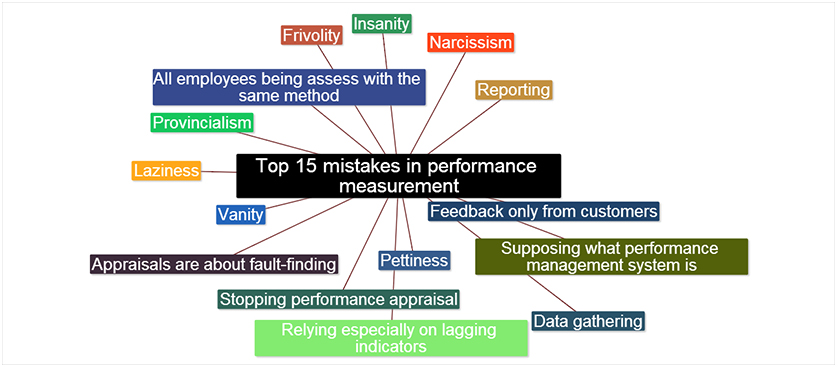Top 15 most common mistakes in Performance Measurement
Companies strive to decrease costs by improving performance with their available resources. This leads to the need for measuring performance through strategic measurement systems, based on tools like balanced scorecards, key performance indicators or dashboards. But with measuring performance there comes a questions: what guidelines should be used when defining and using metrics in order to avoid mistakes that seriously impair the usefulness of these tools?
Below are presented the most common mistakes that entities in the field, like Michael Hammer, Profmark, Performance PAM and Business Finance Magazine agree on:
1. Vanity
These are “feel good” measures that give a sense of achieving the objectives. Everyone wants a metric that they will score 95%, especially because bonuses and rewards are tied to performance results.
The following example could be offered here: if a metric is designed to measure # Orders delivered complete and on time, the company could take orders only when they have the available resources to make the deliveries on time.
2. Provincialism
This occurs when strategic metrics are determined by departmental or organizational boundaries such as budgets. For example, a fast-food company measures the percent of food that had to be thrown away per day (“Chicken Efficiency”). In order to score 100% Chicken Efficiency, the restaurant stopped cooking chicken at 6:30 p.m. instead of 11.00 p.m. However, this could result in massive customer loss.
3. Narcissism
This happens when companies only look at the half full side of the glass when choosing metrics.
Let’s consider the example of a call center which has a remarkable 86% response rate, their most important KPI. If their products tend to deteriorate over several days, due to a more important indicator for clients, namely product quality, the company’s overall performance could be rated very poorly.
4. Laziness
This is one of the most common mistakes, and it happens when one assumes he knows what is important to measure. This is why websites nowadays have feedback forms, so that clients can rate the products, in order to help companies analyze what they should focus on.
5. Pettiness
Sometimes, companies don’t see the big picture and only measure a part of what is important.
We could offer here the example of a company that focuses on % Customer acquisition, therefore on bringing income from new clients, but chooses to ignore reselling and % Customer retention.
6. Insanity
Many companies implement metrics and tend to forget about the human factor, which will also affect their performance. For example, some HR companies’ employees get bonuses based on the number of contracts and positions filled. If managers give bonuses only for high numbers of signed contracts, the HR company will ultimately have a hard time respecting all contracts.
7. Frivolity
Many companies tend to forget measuring the established metrics, and this is why they don’t understand the value of performance management.
8. Reporting
Most financial reports summarize data for the ongoing month, last month, the variance between them and year to date period. The variation cannot be positive for each month, and managers can search for problems in the wrong place and not react to other important issues.
9. Data gathering
Many companies need to have knowledge about what is going on in order to improve themselves, but there is a difference between the data they collect and the actually useful data. Not only financial aspects should be assessed, but also non-financial indicators.
10. Relying especially on lagging indicators
This can’t predict future development. For example, the % Lost luggage in 2012 can’t predict the lost luggage in 2014. However, monitoring the workload of airport staff handling luggage can indicate how likely it is for such events to occur.
11. Feedback only from customers
Getting feedback only from customer surveys is tricky, as a company could only request feedback from the persons that will offer higher scores. Other feedback sources are employees or different stakeholders. Hiring an independent company to gather the survey data can ensure a higher accuracy of the results.
12. Stopping performance appraisal
Canceling or postponing performance appraisal is a bad idea, because it is important for both the individuals and for the company. The employees need to know clearly what is expected of them and the only way to improve is through constant feedback and periodic performance assessments.
13. Appraisals are about fault-finding
Many employers should shift 180 degrees and make the appraisals about their employees, provide feedback and advices on how to strengthen their weaknesses and improve performance.
14. All employees being assess with the same method
This represents a miss judgement, as employees have different job descriptions and capabilities.
15. Supposing what performance management system is
The mistake here is believing that a performance management system = performance review / appraisal / evaluation. The performance management system also includes selecting, documenting, measuring, reporting and taking decisions based on KPIs results.
References:
- Hammer, M. (2007), The 7 deadly sins of performance management [and how to avoid them], MIT Sloan Management Review
- Brown, M. G. (2011), The ten most common errors in developing performance measures
- Profmark (n.a.), Performance measurement – Some common mistakes
- PerformancePAM Talent Management (2011), Employee performance management 10 common mistakes

Tags: Metrics, Performance Management, Performance Measurement






